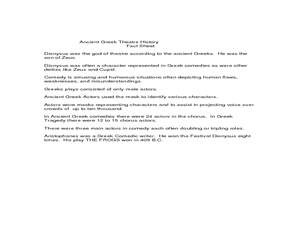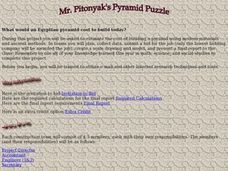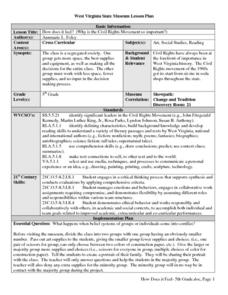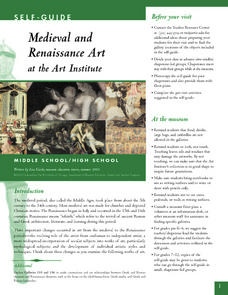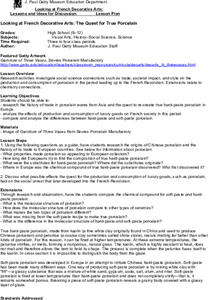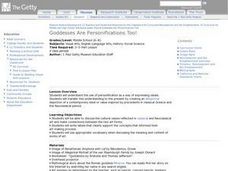Curated OER
What's In A Name?
Students create a binomial system of nomenclature for classifying organisms they encounter in a field trip to a natural history museum or from pictures in library books. They work in small groups to create accurate drawings and place...
Curated OER
Geology of Connecticut
Students examine the geology of Connecticut, including plate tectonics, glaciation, and fossil formation.
After reviewing past lessons, they write essays about what life may have been like in the Mesozoic Period. Following a field...
Curated OER
University of California Botanical Garden Field Trip
Students explore plant species and the climates and conditions in their environment. They explore this living museum on the Garden's thirty-four acres to encounter over 13,000 plant species from around the globe.
Curated OER
Pollen Tracks
Students participate in an artificial dig investigating imitiation rock samples that contain "pollen" from ancient plants. Students determine which plants the pollen samples came from.
Curated OER
Portland Observatory - Images
Students encounter the history and use of a Portland landmark. They explore history, communications, science, and museum visits. Students incorporate how to explore in the Maine Memory Network documents as well. An adventure for any...
Curated OER
Pharaoh Phonetics
Students explain the purpose of hieroglyphics and identify their role in communicating ideas. They research the history of writing and it's significance in ancient Egyptian life and identify the components of hieroglyphics.
Curated OER
Dancing with Dionysus
Sixth graders research Ancient Greek culture by acting in a play for the festival of Dionysus. In this Greek culture lesson, 6th graders study an ancient Greek map and the Sarcophagus Dionysus from the Walters Art Museum website....
Curated OER
Telling Time Timeline
Use the Internet and library resources to compose a telling time timeline -- a visual history of time. Young scholars will develop research skills and gain perspective about telling time by discovering the history of clocks and time.
Curated OER
1,000 Cranes
Young scholars improve motor skills through careful folding, a discipline necessary in the practice of origami. They develop multicultural awareness by exploring Japanese history.
Curated OER
Environmental Impact
Students analyze a 20th century photograph of a Los Angeles landscape and examine the population expansion of L.A. They discuss the principles of design, complete a worksheet, and write a research paper on overpopulation in Los Angeles.
Curated OER
Kidding Around In The 1980s
Young scholars examine pop culture of the 1980s. In this historical time period lesson, students view a Smurfs cartoon from the 1980s and discuss its similarities and differences to cartoons today. Young scholars work in...
Curated OER
Mr. Pitonyak's Pyramid Puzzle
Students determine how much it would cost to build a pyramid using modern materials and ancient methods. They design scale drawings, models and submit final cost bids in an attempt to get the job of building a pyramid.
Curated OER
Land Use and Lawmaking in California
Students investigate the laws of using land. In this California Government lesson, students examine the many uses of land in California and find an environmental issue they care about. Students write a letter to a politician...
Curated OER
Women In Aviation
In this aviation lesson, students take an electronic field trip to the Aviation Museum of Kentucjy. In the process the lesson looks at women in aviation history. The focus is upon how they could be considered heroes or role models. The...
Curated OER
How does it feel? Why is the Civil Rights Movement so Important?
Fifth graders study the Civil War. In this US history lesson, 5th graders simulate what life was like during the Civil War by having two groups with one group given more materials than the other group. Students then draw a...
Curated OER
Medieval and Renaissance Art at the Art Institute
Students examine several Medieval and Renaissance works of art, including painting and sculpture, at the Art Institute of Chicago. They use worksheets and discussion questions to enhance their interpretation of the pieces.
Theodore Roosevelt Association
Roosevelt's Legacy: Conservation
The legacy of Theodore Roosevelt carries through modern American politics, economics, foreign policy, and society. But his proudest and most profound efforts were in the world of conservation, and in preserving the natural beauty of...
Curated OER
Flawed Democracies
Ninth graders examine the struggle for equal opportunity. In this American Government lesson plan, 9th graders create a timeline outlining various groups' struggles for equal opportunity. Students research and construct a timeline to...
Curated OER
Looking at French Decorative Arts
Students research the history of trade in porcelain wares from Asia and the quest to re-create true hard-paste porcelain in Europe and art in French society. In this French art lesson, students research and discuss the possible...
Curated OER
Maya Math: From Zero to Nineteen
Students explore counting methods of the ancient Maya, and practice identifying Maya number glyphs.
Curated OER
Secrets and Spies
Students explore the lives of spies. In this secret government agencies instructional activity, students visit the Imperial War Museum and the Essex Secret Bunker online or in person to discover details about Britain's spies and...
Curated OER
About Life: The Photographs of Dorothea Lange
Students use art to analyze a period in history. In this lesson plan about the effect of art on history, students study many different pieces of photography by Dorothea Lange. Students will observe photographs from certain time periods...
Curated OER
Footprint Detectives: Making Inferences Using Dinosaur Trackways
Young scholars analyze and discuss footprints and dinosaur tracks. They listen to books about paleontologists, create and analyze their own trackways using black paper and chalk, examine the data, and form hypotheses about footprints and...
Curated OER
Goddesses are Personifications Too!
Students analyze the use of personification in classical Greek art and the Neoclassical period. In this Neoclassical art lesson, students discuss the cultural values reflected in classical and Neoclassical....








